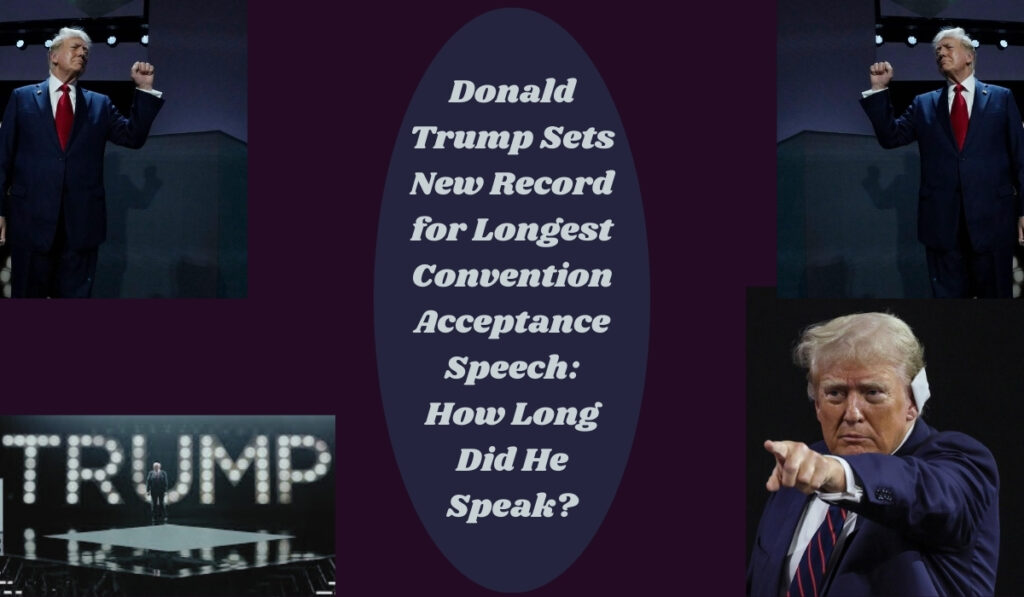The political stage is often dominated by momentous speeches, with convention acceptance speeches being among the most pivotal. These speeches offer a glimpse into the future plans of a candidate, their vision, and their ability to rally supporters. In this context, Donald Trump’s acceptance speeches stand out, particularly because he has managed to surpass his own record for the longest convention acceptance speech. But how long was it? Let’s delve into the details of this remarkable record.
The Significance of Convention Acceptance Speeches
Convention acceptance speeches are more than just formalities; they are strategic tools used to communicate a candidate’s key messages to a broad audience. These speeches set the tone for the campaign, offering a detailed outline of the candidate’s agenda, and aiming to galvanize support. For Donald Trump, known for his charismatic and often unconventional public speaking style, these speeches are particularly significant.
Donald Trump’s First Record-Breaking Speech
In 2016, Donald Trump delivered an acceptance speech at the Republican National Convention that lasted a remarkable 1 hour and 15 minutes. This speech was noted not only for its length but also for its detailed content, which covered a wide range of topics from economic plans to national security. The speech was meticulously crafted to address the concerns of American voters, emphasizing Trump’s commitment to “Make America Great Again.”
Key Highlights from the 2016 Speech
- Economic Revitalization: Trump promised to bring back jobs to America, emphasizing his plans to renegotiate trade deals and reduce regulations.
- National Security: He pledged to strengthen the U.S. military and combat terrorism, with a particular focus on defeating ISIS.
- Law and Order: Trump highlighted the need for restoring law and order, addressing the concerns of crime and violence in urban areas.
Surpassing His Own Record in 2020
Fast forward to 2020, Donald Trump once again took to the stage at the Republican National Convention, delivering a speech that exceeded his previous record. This time, his acceptance speech lasted an unprecedented 1 hour and 11 minutes, surpassing his 2016 speech by a significant margin. This speech was delivered against the backdrop of a highly polarized political environment and a global pandemic, making its content and length even more noteworthy.
Themes of the 2020 Speech
- Response to the Pandemic: Trump outlined his administration’s response to the COVID-19 pandemic, highlighting efforts to accelerate vaccine development and economic relief measures.
- Economic Achievements: He recapped the economic growth experienced during his first term, despite the setbacks caused by the pandemic.
- Future Plans: The speech laid out his vision for a second term, focusing on continued economic growth, healthcare reforms, and strengthening national security.
Analysis of Trump’s Oratory Style
Donald Trump‘s oratory style is characterized by its directness, use of simple language, and ability to connect with his audience. His speeches often include personal anecdotes, rhetorical questions, and repetition of key phrases to emphasize his points. This style, combined with the extensive length of his speeches, allows him to cover many topics in detail, ensuring that his core messages are communicated to his audience.
The Impact of Lengthy Speeches
The length of Trump’s convention acceptance speeches serves multiple purposes:
- Comprehensive Coverage: Longer speeches allow for a thorough discussion of policies and plans, providing voters with a clear understanding of the candidate’s platform.
- Media Attention: Extended speeches often receive significant media coverage, ensuring that key points are disseminated widely.
- Audience Engagement: Despite their length, Trump’s speeches are designed to maintain audience engagement through varied content and a dynamic delivery style.
Comparing with Historical Speeches
To fully appreciate the significance of Trump’s record-breaking speeches, it’s essential to compare them with historical convention acceptance speeches. Traditionally, these speeches range from 30 to 60 minutes. For instance, Barack Obama’s 2008 acceptance speech lasted 45 minutes, focusing on themes of hope and change. Bill Clinton’s 1992 speech was approximately 50 minutes long, emphasizing economic recovery and social progress.
Trump’s speeches, by contrast, not only exceed these in length but also in the breadth of topics covered, reflecting his unique approach to public speaking and campaign strategy.
Reactions and Criticisms
While Trump’s lengthy acceptance speeches have been praised by his supporters for their detailed policy outlines and charismatic delivery, they have also faced criticism. Detractors argue that the extended length can lead to information overload and decreased audience retention. Additionally, the content of his speeches has often been scrutinized for factual accuracy and divisive rhetoric.
Supporters’ Viewpoint
Supporters appreciate the depth and clarity in Trump’s speeches, viewing them as a testament to his dedication and thorough understanding of the issues at hand. The detailed nature of these speeches is seen as an effort to address the concerns of American voters directly.
Critics’ Perspective
Critics, on the other hand, argue that the length can be excessive and the content repetitive. They also point out that longer speeches may not necessarily equate to greater persuasiveness or effectiveness in conveying a message.
Conclusion
Donald Trump’s record-breaking convention acceptance speeches are a significant aspect of his political persona. The lengths of these speeches, surpassing historical norms, reflect his unique approach to engaging with his audience and communicating his vision for the country. Whether viewed as a strength or a point of contention, there is no denying that Trump’s speeches have left an indelible mark on the political landscape.
Donald Trump delivered the longest convention acceptance speech in history at the 2024 Republican National Convention in Milwaukee, lasting over 92 minutes. This surpassed his previous record from the 2016 convention. The speech focused heavily on law and order, security issues, and opposing trade deals. It received mixed reactions, with some praising its energy and others criticizing its length and lack of excitement.
For more detailed information, you can refer to the sources from Brookings, Poynter, and other reports on the event (Brookings) (Poynter).

